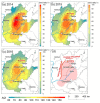Understanding the Spatial-Temporal Patterns and Influential Factors on Air Quality Index: The Case of North China
- PMID: 31394837
- PMCID: PMC6720772
- DOI: 10.3390/ijerph16162820
Understanding the Spatial-Temporal Patterns and Influential Factors on Air Quality Index: The Case of North China
Abstract
North China has become one of the worst air quality regions in China and the world. Based on the daily air quality index (AQI) monitoring data in 96 cities from 2014-2016, the spatiotemporal patterns of AQI in North China were investigated, then the influence of meteorological and socio-economic factors on AQI was discussed by statistical analysis and ESDA-GWR (exploratory spatial data analysis-geographically weighted regression) model. The principal results are as follows: (1) The average annual AQI from 2014-2016 exceeded or were close to the Grade II standard of Chinese Ambient Air Quality (CAAQ), although the area experiencing heavy pollution decreased. Meanwhile, the positive spatial autocorrelation of AQI was enhanced in the sample period. (2) The occurrence of a distinct seasonal cycle in air pollution which exhibit a sinusoidal pattern of fluctuations and can be described as "heavy winter and light summer." Although the AQI generally decreased in other seasons, the air pollution intensity increased in winter with the rapid expansion of higher AQI value in the southern of Hebei and Shanxi. (3) The correlation analysis of daily meteorological factors and AQI shows that air quality can be significantly improved when daily precipitation exceeds 10 mm. In addition, except for O3, wind speed has a negative correlation with AQI and major pollutants, which was most significant in winter. Meanwhile, pollutants are transmitted dynamically under the influence of the prevailing wind direction, which can result in the relocation of AQI. (4) According to ESDA-GWR analysis, on an annual scale, car ownership and industrial production are positively correlated with air pollution; whereas increase of wind speed, per capita gross domestic product (GDP), and forest coverage are conducive to reducing pollution. Local coefficients show spatial differences in the effects of different factors on the AQI. Empirical results of this study are helpful for the government departments to formulate regionally differentiated governance policies regarding air pollution.
Keywords: AQI; GWR; North China; influencing factors; spatiotemporal analysis.
Conflict of interest statement
The authors declare no conflict of interest.
Figures











References
-
- Tian Y., Jiang Y., Liu Q., Xu D., Zhao S., He L., Liu H., Xu H. Temporal and spatial trends in air quality in Beijing. Landsc. Urban Plan. 2019;185:35–43. doi: 10.1016/j.landurbplan.2019.01.006. - DOI
-
- Halkos G., Tsilika K. Understanding transboundary air pollution network: Emissions, depositions and spatio-temporal distribution of pollution in European region. Resour. Conserv. Recycl. 2019;145:113–123. doi: 10.1016/j.resconrec.2019.02.014. - DOI
Publication types
MeSH terms
Substances
LinkOut - more resources
Full Text Sources
Other Literature Sources
Medical

